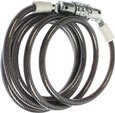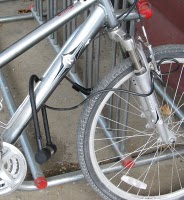5 Tips: Preventing Bike Theft
 1. Choose a lock based on your needs
1. Choose a lock based on your needs
Any bike lock can really only keep honest people honest. Just like car thieves, professional bike thieves have ways to get the bike they want. You want to make your bike look like the least attractive option to a potential thief. However, you can improve your odds by choosing a bike lock that provides a level of security appropriate for the area that you plan to leave your bike parked.
A small, lightweight cable lock is usually good enough for quick mid-ride stops at local coffee shops. On the other hand, if you're leaving your bike unattended all day while you're at work or school, you'll want a heavy-duty chain that provides maximum security.
The smaller the lock, the lower the security, but the easier it is to carry with you. The larger the lock, the more security it provides, but it will be heavier and more cumbersome to carry.
Historically, urban centers and college campuses (even those in "nice" neighborhoods) have the highest rates of bicycle theft. An opportunistic thief can strike anywhere, though, so don't let your guard down when you're in suburban or rural areas, either. A common occurrence is bikes being taken from open garage doors while the owner is busy mowing the lawn, etc.
2. Key or combination?
 Choose the lock type that best matches your habits. Some people prefer key locks, as people are prone to forget combinations. However, keys can be lost or misplaced. Many lock manufacturers offer registration service to replace lost keys, or keep a record of your combination for you, so check the product packaging or ask the staff of your local bike shop for more information.
Choose the lock type that best matches your habits. Some people prefer key locks, as people are prone to forget combinations. However, keys can be lost or misplaced. Many lock manufacturers offer registration service to replace lost keys, or keep a record of your combination for you, so check the product packaging or ask the staff of your local bike shop for more information.
Key locks are more prone to be picked than combination locks, but many of the highest-quality key locks are pick-resistant. A determined thief can try many combinations, or similar to computer passwords, somebody who knows you can guess your combination through clever social engineering (e.g. trying birthdays, anniversaries, etc.). A four-digit combination lock has 10,000 possible combinations, and on average, you can try 1,000 combinations in about 15 minutes. So, anyone with enough persistance (and time) can break any combination lock.
3. Lock your bike frame AND wheels to an immovable object
 For maximum security, your lock cable or chain should be long enough to wrap around the bike's frame, both wheels, and whatever you are locking your bike to. If you just lock one of your wheels to something, then a thief can remove the wheel and take the rest of the bike. Conversely, if you just lock the frame, then your expensive wheels are vulnerable, especially if they use quick-release attachments. If you can't include both wheels, then wrap the lock around the frame and the front wheel--many casual thieves will be intimidated enough not to try removing the rear wheel from the chain. The combination of a u-lock and long cable provides the most secure and versatile way to lock up every major part of your bike. See this article for more detailed tips on how to properly lock your bike to a bike rack.
For maximum security, your lock cable or chain should be long enough to wrap around the bike's frame, both wheels, and whatever you are locking your bike to. If you just lock one of your wheels to something, then a thief can remove the wheel and take the rest of the bike. Conversely, if you just lock the frame, then your expensive wheels are vulnerable, especially if they use quick-release attachments. If you can't include both wheels, then wrap the lock around the frame and the front wheel--many casual thieves will be intimidated enough not to try removing the rear wheel from the chain. The combination of a u-lock and long cable provides the most secure and versatile way to lock up every major part of your bike. See this article for more detailed tips on how to properly lock your bike to a bike rack.
Lock your bike to an enclosed object that won't let the lock be slipped off. Ideally, use a bike parking rack, if available. If you have to use a free-standing pole, such as a parking meter or sign post, be sure that it's high enough or bulky enough that your bike and lock can't just be lifted right over the top. Check local ordinances to be sure that there are no restrictions against locking bikes to parking meters, signs, trees, or other public property. Respect private property, and don't block access to doors, stairways, sidewalks, wheelchair ramps, etc.
4. Choose a location carefully, balancing protection with visibility
Choosing a good location to leave your bike unattended can be a trade-off situation. If you choose a secluded, out-of-the way location, then it might be less likely to be noticed. However, a secluded location provides a thief a better place to work on taking your bike without being noticed by a passing law enforcement officer or good samaritan.
The best balance of seclusion and visibility might be a commercial parking garage, since only others using the garage are likely to be passing by your bike, and the area might be patrolled by the garage staff on a regular basis. If your workplace has dedicated bike parking, use it, but still be sure to use your lock. Bring your bike into your workplace with you, if your employer allows it. Finally, use your lock even when your bike is parked in your own garage at home. The open garage door has often provided a too-easy opportunity for the bike thief passing by your neighborhood.
5. Keep a record of your bike and the serial number
Keep your purchase receipt. Find the serial number of your bicycle, and make a note of it in your records at home if it's listed on your receipt. Keep a picture of the bike with your records, too.
In the unfortunate event that your bike is ever stolen, the serial number can help get your bike back. Many law enforcement agencies, when they recover stolen property, know to look for the serial numbers on bikes, and look them up in one of several bike registration databases. At the very least, they often call local bike shops to check if they have any record of the number.
You can register your bicycle to help make the recovery process easier should it ever be stolen.
